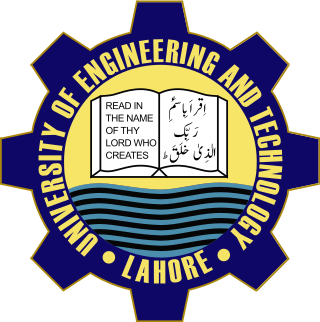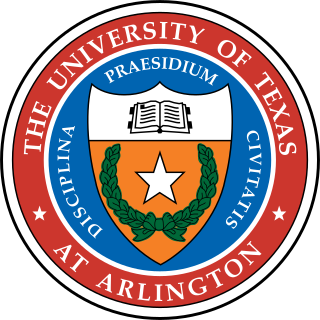
The J. B. Speed School of Engineering was founded in 1925 as part of the University of Louisville in the U.S. state of Kentucky with money from the James Breckenridge Speed Foundation which was created by his children William S. Speed and Olive Speed Sackett to honor J. B. Speed. Until 2003, it was known as the J. B. Speed Scientific School.

The University of Engineering and Technology, Lahore is a public university located in Lahore, Punjab, Pakistan specializing in science, technology, engineering, and mathematics (STEM) subjects. It is the oldest and one of the most selective engineering institutions in Pakistan.

The University of Texas at Arlington is a public research university in Arlington, Texas. The university was founded in 1895 and was in the Texas A&M University System for several decades until joining the University of Texas System in 1965.

The College of Engineering is a division of Cornell University that was founded in 1870 as the Sibley College of Mechanical Engineering and Mechanic Arts. It is one of four private undergraduate colleges at Cornell that are not statutory colleges.
Santa Clara University School of Engineering was founded and began offering bachelor's degrees in 1912. Over the next century, as the Santa Clara Valley transformed from a largely agricultural area to an industrial center, the school added master and doctoral programs designed to meet the area's growing need for expert engineers. Today, the Silicon Valley provides a setting for the school's programs offered through a broad range of departments.
The Engineering Campus is the colloquial name for the portions of campus surrounding the Bardeen Quadrangle and the Beckman Quadrangle at the College of Engineering at the University of Illinois at Urbana–Champaign. It is an area of approximately 30 square blocks, roughly bounded by Green Street on the south, Wright Street on the west, University Avenue on the north, and Gregory Street on the east.

The Khajeh Nasir Toosi University of Technology is a public research university in Tehran, Iran. It is named after medieval Persian scholar Khajeh Nasir Toosi. The university is considered one of the most prestigious institutions of higher education in Iran. Acceptance to the university is highly competitive, entrance to undergraduate and graduate programs typically requires scoring among the top 1% of students in the Iranian University Entrance Exam.
San Diego State University College of Engineering provides San Diego State University students with undergraduate and graduate engineering education. The College of Engineering offers eight degree programs. The Aerospace Engineering, Civil Engineering, Computer Engineering, Electrical Engineering, Environmental Engineering, Mechanical Engineering, and Construction Engineering programs are accredited by the Engineering Accreditation Commission of ABET.

Wendell Herman Nedderman was an American academic administrator who was president of the University of Texas at Arlington for nearly 20 years, first as acting president, then as president, leaving that post in July 1992. He began his 33 years of full-time service at UT Arlington in 1959 as the founding dean of the College of Engineering. This was followed by four years as vice president for academic affairs, and then 20 years as president. A campus engineering building was named Nedderman Hall in 1991 by the UT System board of regents. Campus Street and a portion of Monroe Street were combined and named Nedderman Drive by the City of Arlington in 1992. He was named president emeritus in 1992, and received the Mirabeau B. Lamar Award for Leadership in Learning from the Association of Texas Colleges and Universities. He was awarded the Anson Marston Medal for Achievement in the Field of Engineering in 2000 from Iowa State University.

Jack Royce Woolf was an American academic who arrived at Arlington State College in 1957 as dean of the college. After one year as dean, the Texas A&M Board appointed him acting president in 1958 and president in 1959. In 1967, upon the university leaving the Texas A&M System for the University of Texas System and with the accompanying name change, Woolf became president of The University of Texas at Arlington. Woolf resigned the presidency in 1968, but continued service to the university until 1989.

The University of Pennsylvania School of Engineering and Applied Science is the undergraduate and graduate engineering school of the University of Pennsylvania, a private research university in Philadelphia. The school offers programs that emphasize hands-on study of engineering fundamentals while encouraging students to leverage the educational offerings of the broader University. Engineering students can also take advantage of research opportunities through interactions with Penn’s School of Medicine, School of Arts and Sciences and the Wharton School.

The Herbert Wertheim College of Engineering is the largest professional school, the second largest college, and one of the top three research units at the University of Florida. The college was founded in 1910, and in 2015 was named in honor of Herbert Wertheim – a serial inventor, philanthropist and UF Distinguished Alumnus. Located on the university's Gainesville, Florida campus, the college is composed of nine departments, 15 degree programs, and more than 20 centers and institutes. It produces research and graduates in more than a dozen fields of engineering and science including: aerospace, agricultural, biological, biomedical, chemical, civil, coastal, computer, computer science, digital arts, electrical, environmental, industrial, materials, mechanical, nuclear, and systems.

The Swanson School of Engineering is the engineering school of the University of Pittsburgh in Pittsburgh, Pennsylvania. Founded in 1846, the Swanson School of Engineering is the second or third oldest in the United States.
The Irwin and Joan Jacobs School of Engineering is an undergraduate and graduate-level engineering school offering BS, BA, MEng, MS, MAS and PhD degrees at the University of California, San Diego in San Diego, California. The Jacobs School of Engineering is the youngest engineering school of the nation's top ten, the largest by enrollment in the University of California system, as well as the largest engineering school on the West Coast and the ninth-largest in the country. More than thirty faculty have been named members of the National Academies. The current dean of the Jacobs School of Engineering is Albert P. Pisano. The Jacobs School of Engineering sends a monthly news email which anyone can subscribe to.
The University of Missouri College of Engineering is one of the 19 academic schools and colleges of the University of Missouri, a public land-grant research university in Columbia, Missouri. The college, also known as Mizzou Engineering, has an enrollment of 3,204 students who are enrolled in 10 bachelor’s programs, nine master’s programs and seven doctorate programs. There are six academic departments within the College: Biomedical, Biological and Chemical Engineering; Civil and Environmental Engineering; Electrical Engineering and Computer Science; Industrial and Manufacturing Systems Engineering; Information Technology; and Mechanical and Aerospace Engineering. The college traces its beginning to the first engineering courses taught west of the Mississippi River in 1849. The college was ranked 88th nationally by the U.S. News & World Report in 2016.

The College of Engineering is a college within the University of Notre Dame. The Dean of the College of Engineering is Patricia J. Culligan, Ph.D. Its graduate school for Engineering is ranked #47 in the USA and #15 for undergraduate.

The history of the University of Texas at Arlington began with the foundation of Arlington College in 1895, which was the first of a series of private schools to exist on the site of the present university. Created largely due to the underfunded and generally inadequate public schools in the city, it closed in July 1902 after Arlington voters passed a proposition to create an independent school district. Carlisle Military Academy was established on the same site by Colonel James M. Carlisle in 1902. It was molded by Carlisle's educational philosophy, which balanced intellectualism with military training. Carlisle's financial problems resulted in the school entering receivership in 1911, and in 1913 the school closed. In September 1913, Arlington Training School was founded by H. K. Taylor. The school was beset by financial troubles and lawsuits, ultimately closing after the 1915–16 academic year. In 1916, Arlington Military Academy was founded by John B. Dodson, and it lasted for only one academic year.

In April 1965, the Texas Legislature transferred Arlington State College (ASC) from the Texas A&M University System to the University of Texas System. The following year, Maxwell Scarlett was the first African-American graduate in ASC history. In March 1967, ASC was renamed the University of Texas at Arlington (UTA). Jack Woolf, president of ASC and UTA since 1959, resigned in 1968 and was succeeded by Frank Harrison; Harrison was president until 1972. UTA awarded its first master's degrees in 1968, all in engineering. Reby Cary, the university's first African-American administrator, was hired the following year.

The Syracuse University College of Engineering and Computer Science is one of the 13 schools and colleges of Syracuse University. The College offers more than 30 programs in four departments – Biomedical and Chemical Engineering; Civil and Environmental Engineering; Electrical Engineering and Computer Science; and Mechanical and Aerospace Engineering and The College.

















